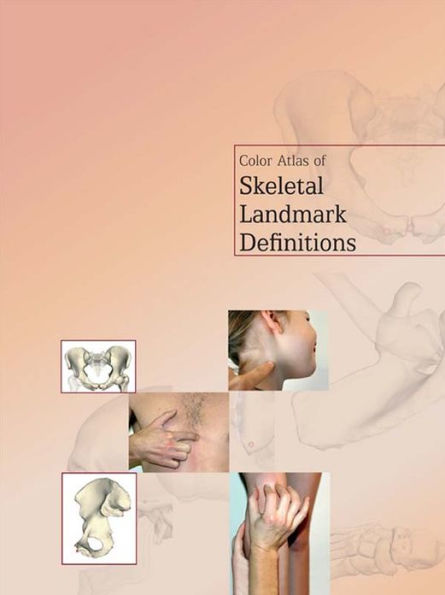Table of Contents
ForewordAcknowledgements1 Introduction2 Skull*External occipital protuberance (SOP) [M}*Zygomatic arch (SZR) [R,L]*Zygomatic angle (SZA)[R,L]*Mastoid process (SMP)[R,L]*Supraorbital notch (SSN)[R,L]*Infraorbital foramen(SIF)[R,L]*Lateral corner of orbit (SLC)[R,L]*Lower edge of orbit (SLE)[R,L]*Nasion (SNA)[M]*GLabella (SGL)[M]*Anterior nasal spine (SNS)[M]3 Jaw*Angle (JAN)[R,L]*Mental protuberance(JMP)[M]*Inferior crest (JIC)[M]*Incisive(JIN)[M]4 Spine*Spinous process (CV2 to CV7, TV1 to TV12, LV1 to LV5)[M]5 Sternum*Jugular notch (SJN)[M]*Clavicular surface (SCS)[R,L]*Manubriosternal edge (SME)[M]*Xiphisternal joint (SXS)[M]6 Ribs*Anterior aspect (RA2 to RA7)[R,L]*Medial aspect (RM2 to RM7)[R,L]*Lateral aspect (RL4 to RL10)[R,L]7 Clavicle*Acromioclavicular joint (CAJ)[R,L]*Anterior concavity (CAA) [R,L]*Anterior convexity (CAE)[R,L]*Sternoclavicular joint (CSJ)[R,L]*Anterior sternoclavicular joint (CAS)[R,L}8 Scapula*Inferior angle (SIA)[R,L]*Root of spine (SRS)[R,L]*Superior angle (SSA)[R,L]*Acromial angle (SAA) [R,L]*Acromial tip (SAT)[R,L]*Acromial edge (SAE)[R,L]*Coracoid tip (SCT) [R,L]*Acromioclavicular joint (SAJ) [R,L]9 Humerus*Greater tubercle (HGT)[R,L]*Lesser tubercle (HLT)[R,L]*Deltoid tuberosity(HDT) [R,L]*Medial epicondyle (HME, HMU, HML)[R,L]*Lateral epicondyle (HLE)[R,L]10 Ulna*Olecranon (UOA, UOM, UOL)[R,L]*Olecranon basis (UOB)[R,L]*Coronoid process (UCP)[R,L]*Dome (UHD)[R,L]*Head (UHE)[R,L]*Styloid process (USP)[R,L]*Distal radioulnar joint (URU)[R,L]11 Radius*Head (RHE)[R,L]*Styloid process (RSP)[R,L]*Dorsal tubercle (RDT)[R,L]*Dorsal edge of distal radio-ulnar joint (RDE)[R,L]*Sigmoid notch (RSN)[R,L]12 Hand*Pisiformis (HPI)[R,L]*Hamatum hook (HHH)[R,L]*Navicular tubercle (HNT)[R,L]*Basis (MBi)[R,L]*Head (HLi, HMi)[R,L]*Sesamoid bones (MSL, MSM)[R,L]*Basis (Bpi, BCi, BDi)[R,L]*Head (PLi, PMi, CLi, CMi, DLi, DMi)[R,L]13 Sacral bone*Spinous process of 2nd sacral vertebrae (SS2)[M]14 Iliac bone*Anterior superior iliac spine (IAS)[R,L]*Posterior superior iliac spine (IPS)[R,l}*Posterior inferior iliac spine (IPI)[R,L]*Ischial tuberosity, inferior angle (IIT)[R,L]*Pubic joint, anterior angle (IPJ)[M]*Pubis spine (IPP)[R,L]*Crest tubercle (ICT)[R,L]*Centre of acetabulum (IAC)[R,L]15 Femur*Greater trochanter (FTc, FTa, FTp)[R,L]*Tubercle of the adductor magnus muscle (FAM)[R,L]*Medial epicondyle (FME)[R,L]*Medial sulcus (FMS)[R,L]*Lateral epicondyle (FLE, FUE, FBE) [R,L]*Popliteal sulcus (FPS)[R,L]*Antero-medial ridge of the patellar surface groove (FMG)[R,L]*Antero-lateral ridge of the patellar surface groove (FLG) [R,L]*Most distal point of the medial condyle (FMC)[R,L]*Most distal point of the lateral condyle (FLC)[R,L]*Center of head (FCH)[R,L]16 Patella*Apex (PAX)[R,L]*Centre of medial edge (PME)[R,L]*Centre of lateral edge (PLE)[R,L]*Centre (PCE)[R,L]17 Tibia*Tibial tuberosity (TTC, TTM, TTL) [R,L]*Medial ridge of tibial plateau (TMR)[R,L]*Lateral ridge of tibial plateau (TLR)[R,L]*Gerdy’s tubercle (TGT)[R,L]*Apex of the medial malleolus (TAM)[R,L]18 Fibula*Apex of the styloid process (FAX)[R,L]*Neck (FNE) [R,L]*Apex of the lateral malleolus (FAL)[R,L]19 Foot*Posterior surface (FCC, FCM, FCL)[R,L]*Sustentaculum tali (FST) [R,L]*Tuberosity (FNT)[R, L]*Greater apophysis (FGA)[R,L]*Neck (FNK) [R, L]*Head (FHE) [R, L]*Peroneal trochlea (FPT) [R, L]*Tuberosity of 5th metatarsal bone (FMT) [R, L]1st, 2nd, 3rd, 4th and 5th head (FM1, FM2, FM3, FM4, FM5) [R, L]*Basis (Bpi, BCi, BDi) [R, L]*Head (PLi, PMi, CLi, CMi, DLi, DMi) [R, L]20 Approximation of centroid and radiusIndex



